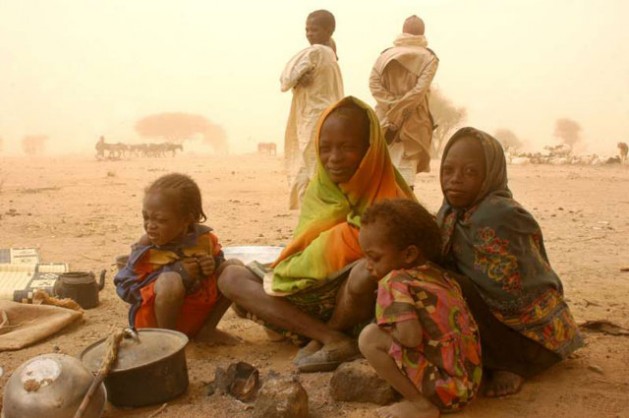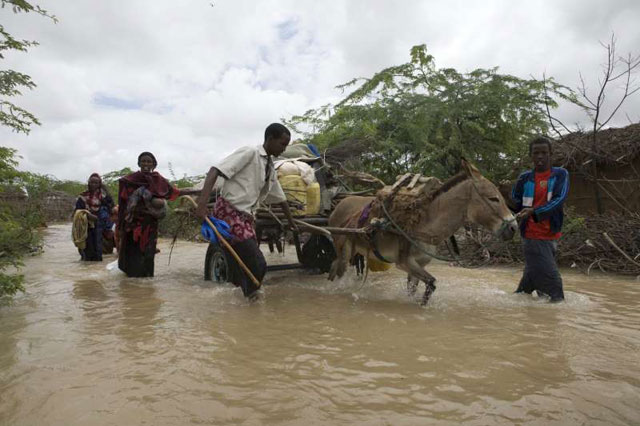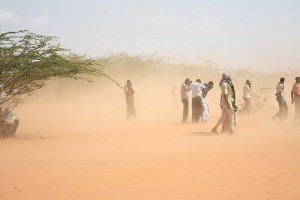War on Climate Terror (II): Fleeing Disasters, Escaping Drought, Migrating
ENVIRONMENT, 15 Aug 2016
Baher Kamal – Inter Press Service-IPS
 11 Aug 2016 – “No one can deny the terrible similarities between those running from the threat of guns and those fleeing creeping desertification, water shortages, floods and hurricanes.”
11 Aug 2016 – “No one can deny the terrible similarities between those running from the threat of guns and those fleeing creeping desertification, water shortages, floods and hurricanes.”
Hardly a short, simply-worded statement could so sharply describe the ignored human drama of millions of victims of man-made wars, violence, poverty and disasters like the one spelled out by the authoritative voice of Prof. Dr. Konrad Osterwalder, the former rector of United Nations University, a global think tank and postgraduate teaching organisation headquartered in Japan.
But while widespread violence and climate catastrophes are common to all continents and countries, there is an overwhelming consensus among experts, scientific community and international specialised organisations that Africa is the most impacted region by them.
Only second to Asia, both extension and population wise, Africa is on the one hand home to nearly half of some 40 on-going armed conflicts. On the other, this continent made of 54 states and 1,2 billion inhabitants, is the most hit region by all sorts of consequences of growing climate change—to which by the way it is the least originator.

Young, new arrivals from Sudan’s Darfur region endure a sandstorm in the border town of Bamina, eastern Chad. Rainfall in this region has been in decline since 1950. This, coupled with deforestation, has had a devastating effect on the environment. Credit: ©UNHCR/H.Caux
Key Facts
The cause-effect relationship between climate and massive population movement is already an indisputable fact. See what world specialised organisations say:
- – Droughts combined with population growth, a lack of sustainable land and water management, natural disasters, political conflicts and tensions and other factors have resulted in massive population movements across Africa, the United Nations Environment Programme (UNEP) reports.
Displacement in Africa is the result of a multitude of causes including struggles for political power, communal violence, disputes over land, floods, storms and other such natural hazards, it adds. More than half of the world’s fragile states are in sub-Saharan Africa, and some of these states have the largest numbers of internally displaced persons (IDPs).
“Africa has more countries affected by displacement than any other continent or region, and was home to more than 15 million internally displaced persons in 2015.”
In short, “the relationship between displacement and the environment is well established in Africa. People leave places with slow-onset environmental degradation, such as drought and desertification and continue to flee rapid on-set environmental emergencies such as tropical storms and flash floods,” says Saidou Hamani, Regional Coordinator for Disasters and Conflict sub-programme, UNEP Regional Office for Africa.

Somali refugees flee flooding in Dadaab, Kenya. The Dadaab refugee camps are situated in areas prone to both drought and flooding, making life for the refugees and delivery of assistance by UNHCR challenging. Credit:©UNHCR/B.Bannon
- – According to the 2016 Global Report on Internal Displacement, there were 27.8 million new displacements in 127 countries during 2015, roughly the equivalent of the populations of New York City, London, Paris and Cairo combined; of the total, 8.6 million were associated with conflicts and violence in 28 countries, while 19.2 million were associated with disasters in 113 countries.
The growing intensity of meteorological disasters due to climate change, coupled with the effects of environmental degradation is likely to continue being a factor behind human displacement.
— The International Organization of Migration (IOM) predicts there will be 200 million environmentally-displaced people by the year 2050 with major effects on countries of origin, transit countries, as well as receiving countries.
Individuals and communities displaced by disasters and climate change and those displaced by conflicts often experience similar trauma and deprivation. They may have protection needs and vulnerabilities comparable to those whose displacement is provoked by armed violence or human rights abuses. “Climate change is expected to further exacerbate the stress that fragile states are already facing.”
“Africa has more countries affected by displacement than any other continent or region, and was home to more than 15 million internally displaced persons in 2015” – UNEP
In Africa, environmental degradation and food insecurity are related to floods and other factors such as diminishing pasture for cattle as well as water, firewood and other natural resource scarcities, says IOM. Such factors contribute to displacement, resulting in increasing competition for scarce resources, which also contributes to armed conflict, particularly between pastoralists and sedentary communities.
Future forecasts vary from 25 million to 1 billion environmental migrants by 2050, moving either within their countries or across borders, on a permanent or temporary basis, with 200 million being the most widely cited estimate. This figure equals the current estimate of international migrants worldwide.
- – “Changes in the regional climate are impacting issues linked to the availability of natural resources essential to livelihoods in the region, as well as food insecurity. Along with important social, economic and political factors, this can lead to migration, conflict or a combination of the two,” according to Livelihood Security Climate Change, Migration and Conflict in the Sahel.
- – It is evident that gradual and sudden environmental changes are already resulting in substantial population movements, the UN Refugee agency (UNHCR) reports.
“The number of storms, droughts and floods has increased threefold over the last 30 years with devastating effects on vulnerable communities, particularly in the developing world.”
“Climate change and the environment have a big impact on the lives of millions of forcibly uprooted people around the world.”
Many of them rely on the environment for survival, particularly during emergencies – for food, shelter, energy, fire and warmth, medicine, agriculture, income-generation activities and more, adds UNHCR.
“Unsustainable use of natural resources can lead to environmental degradation, with lasting impacts on natural resources and on the well-being of the displaced and host communities. Additionally, competition over scarce natural resources, such as firewood, water and grazing land, can lead to friction.”
- – Gradual changes in the environment tend to have an even greater impact on the movement of people than extreme events. For instance, over the last thirty years, twice as many people have been affected by droughts as by storms (1.6 billion compared with approx. 718m),according to the International Disaster Database.
In 2008, 20 million persons have been displaced by extreme weather events, compared to 4.6 million internally displaced by conflict and violence over the same period.
- – Disasters and climate change are a growing concern. Since 2009, an estimated one person every second has been displaced by a disaster, with an average of 22.5 million people displaced by climate or weather-related events since 2008, according to the International Displacement Monitoring Centre www.internal-displacement.org report. (IDMC 2015).
- – The Intergovernmental Panel on Climate Change, the UN’s science advisory board, projects an increase in the number of displaced over the course of this century. The majority of the people of concern to UNHCR are concentrated in the most vulnerable areas around the world.
Climate change will force people into increasing poverty and displacement, exacerbating the factors that lead to conflict, rendering both the humanitarian needs and responses in such situations even more complex.
Now two key related events are scheduled to take place in the coming days: Africa Drought Conference in Windhoek, Namibia, August 15-19, and the World Humanitarian Day, August 19.
Will this growing, unstoppable human drama deserve the attention of world politicians or at least of the mainstream
_________________________________
Baher Kamal, Egyptian-born, Spanish national secular journalist. He is founder and publisher of Human Wrongs Watch. Kamal is a pro-peace, non-violence, human rights, harmonious coexistence defender among human beings and with Nature, with more than 43 years of professional experience. With these issues in sight, he covered practically all professional posts, from correspondent to chief editor of dailies and international news agencies.
DISCLAIMER: The statements, views and opinions expressed in pieces republished here are solely those of the authors and do not necessarily represent those of TMS. In accordance with title 17 U.S.C. section 107, this material is distributed without profit to those who have expressed a prior interest in receiving the included information for research and educational purposes. TMS has no affiliation whatsoever with the originator of this article nor is TMS endorsed or sponsored by the originator. “GO TO ORIGINAL” links are provided as a convenience to our readers and allow for verification of authenticity. However, as originating pages are often updated by their originating host sites, the versions posted may not match the versions our readers view when clicking the “GO TO ORIGINAL” links. This site contains copyrighted material the use of which has not always been specifically authorized by the copyright owner. We are making such material available in our efforts to advance understanding of environmental, political, human rights, economic, democracy, scientific, and social justice issues, etc. We believe this constitutes a ‘fair use’ of any such copyrighted material as provided for in section 107 of the US Copyright Law. In accordance with Title 17 U.S.C. Section 107, the material on this site is distributed without profit to those who have expressed a prior interest in receiving the included information for research and educational purposes. For more information go to: http://www.law.cornell.edu/uscode/17/107.shtml. If you wish to use copyrighted material from this site for purposes of your own that go beyond ‘fair use’, you must obtain permission from the copyright owner.
